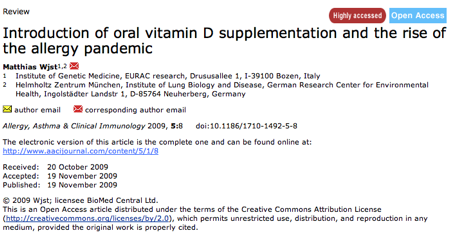It’s an exceptional good science book – Cancer, The evolutionary legacy – by Mel Greaves. Having written last year a grant application about resequencing of lung specimens (and more recently a correspondence letter about the lung cancer genome that updates our earlier 31 events to 22,910) Continue reading Evolutionary legacy
Tolerogenic effects of vitamin D?
A new allergy study published last month
hypothesized that prenatal vitamin D supplementation could induce tolerogenic DC at birth. To evaluate this hypothesis in an epidemiological setting, we quantiï¬ed the gene expression levels of ILT3 and ILT4 in cord blood (CB) samples of a population-based birth cohort of farm and reference children.
ILT3/IL4 as a marker of tolerogenic DCs may be justified by data published by Chang but not by newer data Continue reading Tolerogenic effects of vitamin D?
279 cases of imprinted human loci
igc.otago.ac.nz has a nice list of all imprinted human loci. I have reworked that list and found that most (150) do not have any disease association. Diseases influenced by imprinted marks are Continue reading 279 cases of imprinted human loci
Lamarck and fixation of epigenetic marks
How did epigenetic research start? Thanks to KP I learned about the biography of Paul Kammerer “Der Krötenküsser” by Arthur Köstler. Wikipedia summarizes the rather long (and sad) story Continue reading Lamarck and fixation of epigenetic marks
How we inherit acquired traits – all about non random mutations in the human genome
This is just a material collection for a forthcoming review. I am collecting links to studies showing an increased mutation rate in CpG islands that may possibly fix gene activation status. Continue reading How we inherit acquired traits – all about non random mutations in the human genome
On the tasseography of lung function genes
Having done lung function testing on hundreds, even thousands of children, I believe that this is not an easy task – it’s not only about abdominal mechanics and airway diameter but also about physical fitness – and let’s be cruel – also about intelligence. Even worse, I remember a long discussion how to adjust lung function parameter appropriately – should we use standing or sitting height? Two new papers large ignore these questions. But read first what the Charge consortium writes Continue reading On the tasseography of lung function genes
Rape with extreme violence
This may be an unusual post before Christmas – about the hell on earth for women – our world however, is not a peaceful world. A new study in PLoS Medicine shows this new pathologic behaviour from Panzi Hospital, Bukavu, South Kivu, Congo where doctor Mukwege is working Continue reading Rape with extreme violence
The dirty little secret
A new editorial talks about the dirty little secret of mouse immunology
the striking difference between human and murine sensitivity to LPS toxicity
where humans are 100,000–fold more likely to die of an intravenous dose of LPS. And of course to cite another review on mice and (not) men Continue reading The dirty little secret
100 cases of inherited epigenetic inheritance
I was searching quite long for a review on that – but only to discover in the print version of a QRB article a reference to an online table. In homo sapiens, the author reports an increased cardiovascular mortality slash diabetes susceptibility (INS-IGF2-H19) through male germline and Angelman/Prader/Willi syndrome (from paternal grandmother). So there are only limited human examples so far, which is certainly due to the lack of appropriate sample collections yea, yea.
Addendum 29-Dec-2009
Video Link to an interview with Lars Olov Bygren.
I am still not sure about Angelman/Prader/Willi (as this is more with imprinting) – otherwise the updated list consists of
- Prenatal exposure to the Dutch famine and disease in later life: An overview (2005)
- Sex-specific, male-line transgenerational responses in humans (2006)
- Transgenerational response to nutrition, early life circumstances and longevity (2007)
- Persistent epigenetic differences associated with prenatal exposure to famine in humans (2008)
Careful control of stratification
A careful control of population stratification removes most “significant” SNP associations – shown again at the Genetic Analysis Workshop 16 Continue reading Careful control of stratification
History will tell – new paper online that explains a possible reason of the allergy pandemic
Our most recent paper is online now. Although not even listed in Pubmed, it seems to be already highly accessed ;-) Have fun and sorry for the two typing errors there.

Of course the submission statistics there are misleading; I submitted it last year while publication has been delayed by moving the journal to an Open Source platform.
Burial
Si tacuisses
The BAMSE study group published another vitamin paper – mainly on current multivitamin use and allergy.
Our results …. suggest that supplementation with multivitamins during the first years of life may reduce the risk of allergic disease at school age.
Any further conclusion on early exposure of vitamin D, however, is probably impossible for 3 simple reasons: Continue reading Si tacuisses
First scientific paper of a female scientist?
I am not really sure about that, but I think it may be this letter: Continue reading First scientific paper of a female scientist?
One for all
A research article in Science reports a new CML cell line
We used insertional mutagenesis to develop a screening method to generate null alleles in a human cell line haploid for all chromosomes except chromosome 8.
I couldn’t figure out why chromosome 8 remained but are nevertheless fascinated by the opportunities, yea, yea.